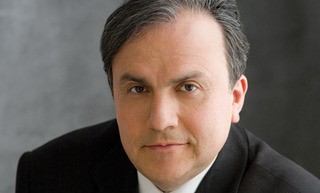|
Back
Free at Last (From The Conductor’s Punishing Stick) New York
92nd Street. Y, Theresa L. Kaufmann Concert Hall
05/23/2014 -
Franz Schubert: Sonatina for Violin and Piano in A minor, D. 385
Béla Bartók: Contrasts for Violin, Clarinet and Piano, sz. 111
Johannes Brahms: Quintet for Piano and Strings in F minor, Op. 34
Mark Nuccio (Clarinet), Glenn Dicterow, Lisa Kim (Violins), Rebecca Young (Viola), Eileen Moon (Cello), Yefim Bronfman (Piano)

Y. Bronfman (© Dario Acosta)
After Yefim Bronfman and Glenn Dicterow finished the opening Schubert Sonatina last night, I vowed to telephone the International Adjective Warehouse this morning to find the right descriptions for such a performance. Alas, they were closed for the Memorial Day Weekend, so my own poor choice will have to suffice.
Let us merely say that the words “Chamber Music” are hardly appropriate for Mr. Bronfman, and all his friends from the New York Philharmonic.
This is a cowardly assessment, to be certain. But when the NY Phil’s beloved Concertmaster launched into the Schubert theme after a few bars by Mr. Bronfman, one could feel helpless under such unremitting power. Not the power of a fist or the electrifying fire when Mr. Bronfman plays a Brahms concerto, but the two musicians who possess the ultimate keys to the music.
Schubert called this piece a “Sonata” which is most assuredly is. Probably to attract amateur players later, the publisher gave it a less prepossessing “Sonatina” moniker. But its relative simplicity only is grist for two players. Messrs Bronfman and Dicterow never gave it less than the full emotional treatment. The secret of these two is that the simplest themes, in the next two movements, were played with an earnestness, a directness, and a respect for the skill that made the simplicity. The ending was more a mystery, an unfolding, a tapestry of continuing shapes.
Mr. Dicterow gave up his seat (so to speak) for Phil player Lisa Kim, augmenting the duo with Mark Nuccio for Bartók’s rarely played Contrasts for violin, clarinet and piano.
Like comics who always long to play Shakespeare, clarinetists Benny Goodman and Woody Herman took their lucre to Bartók and Stravinsky to commission some “serious” music to play. Stravinsky’s Ebony Concerto is not first rate. Bartók’s Contrasts is one of his most ebullient, ferocious, funny and most striking works–when played with all the bravura it deserves.
Mr. Bronfman’s piano was somewhat in the background here, but clarinetist Mark Nuccio totally ran with it. That first movement was played with wit and despair, the clarinet cadenza ripped open clarinet technique (it made Goodman’s own recording somewhat pallid), and going onto all the clarinet motors revving into the highest gears with different vibratos and accents.
(Mr. Nuccio used two clarinets–no, not simultaneously–but I could never figure out why, save that one would have a different color for different sections.
Ms. Kim, a brilliant technician on her own, I felt never quite worked into the whirling dervish-dance of the first movement Verbunkos. It was of course difficult to compete with Mr. Nuccio here, but in the final movement she had her chance. She had her two violins to give the off-key sounds (lowering the E and raising the G up a semitone), but in her cadenza, while the double-stops were exciting, such excitement was no substitute for Bartók’s bluesy slides and jazzy intonations.
Stravinsky’s jazz was a throwaway gift to Woody Herman. Bartók’s exotica was less real jazz than homage to his Hungarian roots. Less a showcase for the two players, which is was, than an unremitting exposition of emotional Magyar hijinks.

G. Dicterow (© Chris Lee)
The two violinists, Mr. Bronfman, violinist Rebecca Young and cellist Eileen Moon–all strings from the Philharmonic–finished with Brahms’ most eclectic Quintet. Those who think of Brahms as a generic composer, had no idea how much he brought into this work. When played with as much panache and devotion as these five players, one felt the most beautiful Schubert lyrics in the second movement, Wagnerian full-orchestral tuttis (I hadn’t realized before that the Ultimate Wagnerian, Hermann Levi, loved it), the power of Beethoven, but yes, the full-blooded Brahms.
It takes more than terrific ensemble playing, it takes the utmost chuzpah to challenge Mr. Bronfman, which they did in the first movement, bringing the piece ever more forward. That Schubertian second movement was played with a serenity and a tranquility only equaled by the opening of the finale.
But I forget the Scherzo. These five players were not playing your traditional third movement, they were almost violent. Individually, each player was competing in Brahms’s cross-rhythms–but as a group once again, they were doing battle with Mr. Bronfman, whose piano raged throughout the entire movement and the Presto non troppo of the finale.
Perhaps the one major difference between this group and a more established “ensemble” is that “chamber” string quartets play it as chamber music. These four are orchestral musicians, unchained from a conductor’s tyranny, breaking free with orchestral amplitude and singular skill to offer an untried, untested musical adventure.
Harry Rolnick
|